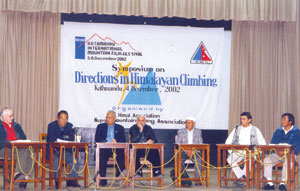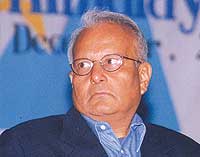 How will Himalayan mountaineering evolve, and how can it be made more relevant to the people living in these mountains? More specifically, why don't urban Nepalis take to climbing as a sport, and what can be done to make the 'locals' benefit more from the economic bonanza of the climbing industry?
How will Himalayan mountaineering evolve, and how can it be made more relevant to the people living in these mountains? More specifically, why don't urban Nepalis take to climbing as a sport, and what can be done to make the 'locals' benefit more from the economic bonanza of the climbing industry? Legendary climbers and knowledgable specialists were addressing these and other issues at a symposium Wednesday on "Directions in Himalayan Climbing". The event was a prelude to the Kathmandu International Mountain Film Festival 2002, which kicked off Thursday.

Seated on the podium in the chilly auditorium of the Russian Cultural Centre were Tashi Jangbu Sherpa, Stipe Bozic, Nawang Gombu, Harish Kapadia, Dr. Harka Gurung and Doug Scott. Brief presentations were followed by an open discussion moderated by Kanak Mani Dixit, editor of Himal. Nawang Gombu, the first man to climb Everest twice and a respected climbing elder who lives in Darjeeling, opened and chaired the symposium.
Climbing in Nepal since the 1970s, Doug Scott is a renowned mountaineer. He made his mark in the climbing world when he summitted Everest by the south-west face in 1975, and went on to be an ace 'alpine style' climber who has lately taken to promoting the welfare of porters.
 To consider the future of mountaineering in Nepal, we must examine the past, suggested Scott in his keynote address. He compared climbers of today to the hunter-gatherer of primitive society. "Resourceful, imaginative, exploratory, and cooperative," were qualities that the hunter-gatherer and the climber both displayed, besides sharing a drive to face uncertainty and risk. They were social beings able "to dip below the usual level of everyday consciousness...to develop spirituality". While on the slopes, the mountaineer relinquishes all that is materially cumbersome, as well as the "shedding of all superfluous thought".
To consider the future of mountaineering in Nepal, we must examine the past, suggested Scott in his keynote address. He compared climbers of today to the hunter-gatherer of primitive society. "Resourceful, imaginative, exploratory, and cooperative," were qualities that the hunter-gatherer and the climber both displayed, besides sharing a drive to face uncertainty and risk. They were social beings able "to dip below the usual level of everyday consciousness...to develop spirituality". While on the slopes, the mountaineer relinquishes all that is materially cumbersome, as well as the "shedding of all superfluous thought". Scott discussed the history of climbing in terms of a "progression of difficulty". Mountains were first tackled the easiest way up, then progressively by more difficult routes. The development of equipment such as nylon ropes and lighter plastic boots enabled a move away from the tedious fixed-rope technique to the Alpine style, a self-contained approach to climbing. "There is something so fantastic about going Alpine style...commitment...going for it," marvelled Scott, who felt that climbing a mountain with lots of fixed rope showed lack of that much-valued 'commitment'.
One of the many critical issues Scott raised was why talented Nepali Sherpas had not blazed the 'alpine climbing' trail. He critiqued the trend towards mass climbing and its negative impacts, particularly on Everest. He lauded mountain porters, and maintained that the minimal wages they received were "intolerable".
 Dr. Harka Gurung introduced himself saying, "I am not a mountaineer...I am a mountain chronicler." He is an eminent Himalayan specialist, and a geographer by academic discipline. Dazzling the audience with his wit, Gurung addressed two critical issues: the fact that mountaineering policies are made in the "plains", and that the people of the mountains are not being properly compensated from the climbing royalty that the national exchequer collects. Answering a question, Dr. Gurung suggested that it might be appropriate if only 50 percent of royalties went to the central government, with the remaining half being put into a trust fund to benefit people of the high Himal.
Dr. Harka Gurung introduced himself saying, "I am not a mountaineer...I am a mountain chronicler." He is an eminent Himalayan specialist, and a geographer by academic discipline. Dazzling the audience with his wit, Gurung addressed two critical issues: the fact that mountaineering policies are made in the "plains", and that the people of the mountains are not being properly compensated from the climbing royalty that the national exchequer collects. Answering a question, Dr. Gurung suggested that it might be appropriate if only 50 percent of royalties went to the central government, with the remaining half being put into a trust fund to benefit people of the high Himal. Harish Kapadia, Bombay-based editor of the Himalayan Journal and a mountaineer who opened many climbing routes in Kumaon, Garhwal and Kashmir, described the state of mountaineering in the Indian Himalaya. Mountaineering in India was concentrated between clubs and groups in the major metropolises, he said. Kapadia's primary concern was the impact of war in Kashmir, which has closed many areas such as the Siachen Glacier to climbers. (He is proposing a peace park in the region.)
Croatian climber and film-maker Stipe Bozic presented his concerns in a brief but succinct manner. The lack of rescue facilities for mountaineers in the Nepal Himalaya, he felt, was a major hurdle in the further development of the sport. He suggested training courses for local climbers as well as the initiation of a system of insurance. Bozic will make a presentation on the "holy mountains" of the world on the evening of 8 December, the last day of the festival.
 Former president of the Nepal Mountaineering Association, Tashi Jangbu Sherpa, provided an overview of mountaineering in Nepal, from the Darjeeling-based Sherpas taking the lead at the turn-of-century through the 'age of exploration', seige-style, and alpine-style, to solo climbing. He suggested that Western climbers had now begun to treat Nepali climbers less as 'porters' and more as peers, which was a positive evolution. However, Tashi Jangbu felt that mountaineering would not develop healthily unless Nepali mountain guides received international certification, such as a modified 'UIAGM' rating system of the kind used in Europe. "Their inherent climbing skills, backed by a recognised guide certificate, will give our climbers the confidence and credibility to be strong leaders," he said.
Former president of the Nepal Mountaineering Association, Tashi Jangbu Sherpa, provided an overview of mountaineering in Nepal, from the Darjeeling-based Sherpas taking the lead at the turn-of-century through the 'age of exploration', seige-style, and alpine-style, to solo climbing. He suggested that Western climbers had now begun to treat Nepali climbers less as 'porters' and more as peers, which was a positive evolution. However, Tashi Jangbu felt that mountaineering would not develop healthily unless Nepali mountain guides received international certification, such as a modified 'UIAGM' rating system of the kind used in Europe. "Their inherent climbing skills, backed by a recognised guide certificate, will give our climbers the confidence and credibility to be strong leaders," he said. Ang Tshering Sherpa, the present president of the Nepal Mountaineering Association (which together with Himal Association organised the symposium), spoke from the floor and made a point-by-point presentation regarding the initiatives being taken regarding training, rescue, revenue-sharing, and the matter of the much-maligned system of the 'liaison officer'.
Following the presentation by the experts, there was a give-and-take session with the audience, and the matters that came up for discussion included debate on the appropriate name - Everest/Chomolongma/Sagarmatha, the matter of royalty-sharing, environmental concerns, and, again, liaison officers.
The symposium closed on a note of introspection, with cultural activist Rinchen Yonjan suggesting from the audience that the private sector ask itself what it had done to promote the "spirit of the Himalaya".


